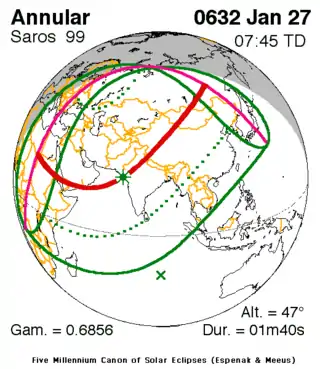| Solar eclipse of January 27, 632 | |
|---|---|
 Solar eclipse of January 27, 632 | |
| Type of eclipse | |
| Nature | Annular |
| Gamma | 0.6856 |
| Magnitude | 0.9836 |
| Maximum eclipse | |
| Duration | (1m 40s) |
| Coordinates | 22°N 70°E / 22°N 70°E |
| Max. width of band | 78.4 km |
| Times (UTC) | |
| Greatest eclipse | 6:38:59 UT |
| References | |
| Saros | 99 (23 of 72) |
The solar eclipse of January 27, 632, also known as Muhammad's Eclipse,[1] was an annular solar eclipse visible in East Africa, Arabian Peninsula, Central Asia, India, and China.[2][3]
Coverage by Islamic history
The eclipse occurred at the time of the death of Ibrahim, a 18-month-old son of Muhammad and rumours of God's personal condolence quickly arose.[4]
But he stood at the mosque and said:
"The sun and the moon do not eclipse because of the death or life of someone. When you see the eclipse pray and invoke Allah."[5]
The eclipse is well documented in Islamic sources but no reference to this event has been found in external sources as of yet.[6]
References
- ↑ "EclipseWise - Eclipses of History: Part 2: Solar Eclipses of the Middle Ages". www.eclipsewise.com.
- ↑ "NASA - Solar Eclipses of History". eclipse.gsfc.nasa.gov.
- ↑ "Nasa, eclipse of January 27, 632" (PDF).
- ↑ "الكتب - البداية والنهاية - سنة إحدى عشرة من الهجرة - فصل في ذكر أولاده عليه وعليهم الصلاة والسلام- الجزء رقم8". Islamic Library. Retrieved 28 November 2019.
- ↑ "Hadith - Book of Eclipses - Sahih al-Bukhari - Sayings and Teachings of Prophet Muhammad (صلى الله عليه و سلم)". Sunnah. Retrieved 28 November 2019.
- ↑ Armstrong, Karen (28 August 2007). Muhammad: A Prophet for Our Time. Harper Collins. ISBN 978-0061155772.
This article is issued from Wikipedia. The text is licensed under Creative Commons - Attribution - Sharealike. Additional terms may apply for the media files.
.jpg.webp)

